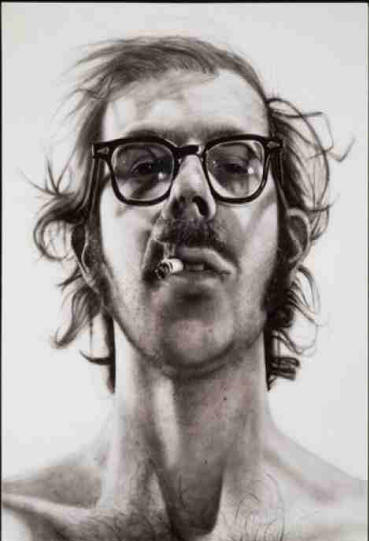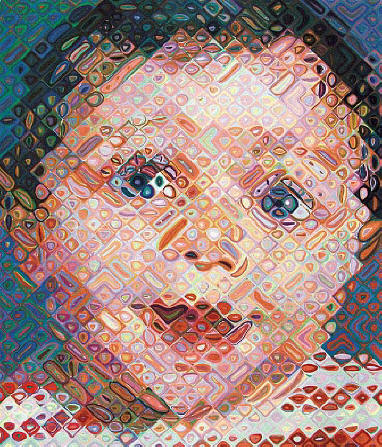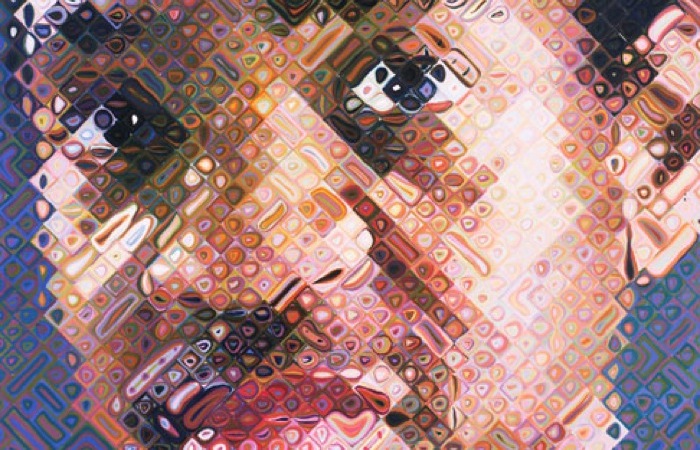-


 Chuck Close
Chuck Close
American
Artist
If any artist's work is a variation on a theme, then it is Chuck Close's, who has been painting portraits with a passion since the late 1960s. Close is an American painter and photographer who achieved fame as a photorealist, through his massive-scale portraits. More than just a painter, photographer, and printmaker, Chuck Close is a builder who, in his words, builds "painting experiences for the viewer."
Chuck Close uses a variety of mediums in his work, including oil, acrylic, ink, graphite, paper pulp, and Polaroid prints.
The perspective over four decades is of finely-honed craft, of obsessive-compulsive application of technique, and of ever-inquiring explorations and extensions of countless possible permutations and combinations of elements within his delineated mode.
The 2002 portrait of his niece Emma is actually a woodcut print based on a painting in Close's late signature style. Chuck spent three months on the painting. Master printer Yasu Shibata spent two years carving 27 woodblocks to print 113 colors 132 times to make each print. Every aspect of the process is like a miraculous innovation, beginning with Close's secret for getting a toddler to sit still for three whole months.
Chuck Close’s paintings are labor intensive and time consuming, and his prints are more so. While a painting can occupy Chuck Close for many months, it is not unusual for one print to take upward of two years to complete. Close has complete respect for, and trust in, the technical processes, and the collaboration with master printers, essential to the creation of his prints. The creative process is as important to Chuck Close as the finished product. "Process and collaboration" are two words that are essential to any conversation about Close’s prints.
Chuck Close's first solo exhibition included a series of enormous black-and-white portraits that he had painstakingly transformed from small photographs to colossal paintings. Close's large, iconic portraits are generated from a system of marking which involves painstaking replication of the dot system of the mechanical printing process. The portraits he produces, utterly frontal, mural-size, and centered in shallow space, replicate the veracity of a photograph and undermine the objectivity of photography at the same time, critics say.
Chuck Close reproduced and magnified both the mechanical shortcomings of the photograph, including blurriness and distortion, and the flaws of the human face: bloodshot eyes, broken capillaries, and enlarged pores.
To make his paintings, Chuck Close superimposed a grid on the photograph and then transferred a proportional grid to his gigantic canvases. He then applied acrylic paint with an airbrush and scraped off the excess with a razor blade to duplicate the exact shadings of each grid in the photo. By imposing such restraints, Close hoped to discover new ways of seeing and creating.
"Big Self-Portrait" (1967-1968), is, indeed, big (nearly nine by seven feet). Chuck Close used acrylic paint and an airbrush to include every detail. This painting took four months to complete. Big Self-Portrait, in black and white, was the first of Close's mural-sized works painted from photographs.
In 1988 a spinal blood clot left Chuck Close almost completely paralyzed and confined to a wheelchair. A brush-holding device strapped to his wrist and forearm, however, allowed him to continue working.
In the 1990s Chuck Close replaced the minute detail of his earlier paintings with a grid of tiles daubed with colorful elliptical and ovoid shapes. Viewed up close, each tile was in itself an abstract painting; when seen from a distance, the tiles came together to form a dynamic deconstruction of the human face.